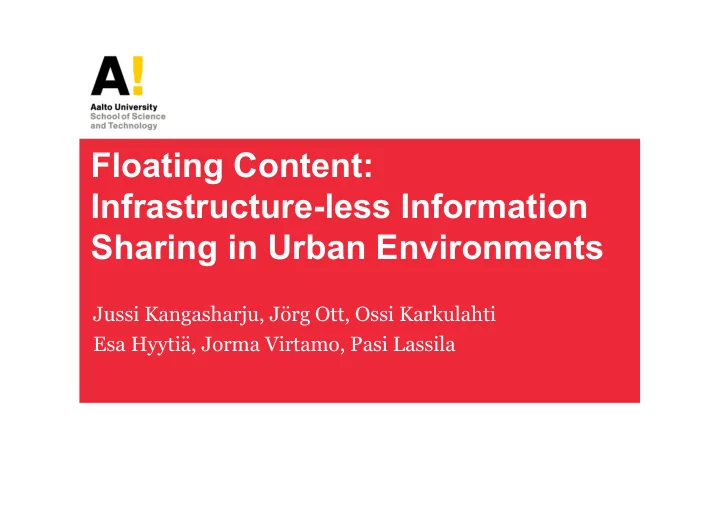

Floating Content: Infrastructure-less Information Sharing in Urban Environments Jussi Kangasharju, Jörg Ott, Ossi Karkulahti Esa Hyytiä, Jorma Virtamo, Pasi Lassila
Infrastructure-less Content Sharing… • Ad-hoc local social network-style information sharing: Digital graffiti w/o servers and infrastructure • Leaves notes, comments, stories, etc. in places • Define reach (area of interest) and lifetime • Leverage delay-tolerant ad-hoc communication between mobile devices for information replication & acquisition – Could borrow content channels from PodNet
…in Urban Environments?! • Location privacy • Content “privacy” • Connectivity (to infrastructure) • Geographic validity • Temporal validity • User identification
Floating Content Example
Floating Model Anchor zone r a Buffer zone
Replication & Deletion Replication Deletion • ƒ(d) from anchor point • Only if buffer space needed • r, a for priority scheduling • ƒ(d) from anchor point • 1 within anchor zone • r, a as tie breakers • TTL-based deletion 1 1 0 0 r a r a
Content spread and prioritization
Some Simulation Findings • ONE Simulator: 2000 x 2000m simulation area • Variables – Radio range: l – Number of nodes: density – Size of anchor zones r – Initial mobility models: static nodes, random waypoint • Metrics RAR : = l Availability : = # nodes in the anchor zone with item # total nodes in the anchor zone r
Mobile (RWP) vs. Stationary Nodes
Impact of mobility and stationary density
Memory: Availability over Time
Some Conclusions • Simple, yet appealing geo cooperation model • Workable already for modestly dense scenarios – Simulations do not disagree with theoretical modeling • Some built-in DoS protection and garbage collection • API and content sharing applications tbd. • Probabilistic operation and user acceptance?
Present & Future Work • Theoretical foundations • More extensive simulation studies – Impact of location fuzziness – More diverse mobility models – Varied offered load, resource sharing • Implementation
Recommend
More recommend